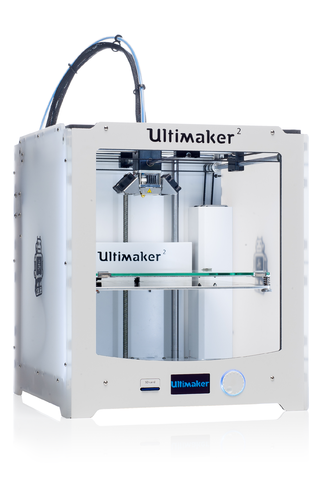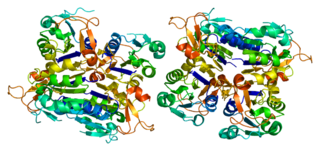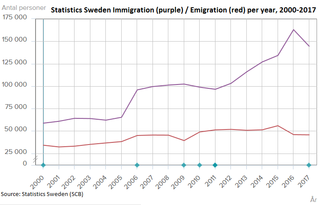
Gothenburg is the capital of Västra Götaland County in Sweden. It is the second-largest city in Sweden, after the capital Stockholm, and the fifth-largest in the Nordic countries. It is situated by the Kattegat on the west coast of Sweden, with a population of approximately 600,000 in the city proper and about 1.1 million inhabitants in the metropolitan area. The city's population increased by 9,292 during 2022.
Microfluidics refers to a system that manipulates a small amount of fluids ( using small channels with sizes ten to hundreds micrometres. It is a multidisciplinary field that involves molecular analysis, biodefence, molecular biology, and microelectronics. It has practical applications in the design of systems that process low volumes of fluids to achieve multiplexing, automation, and high-throughput screening. Microfluidics emerged in the beginning of the 1980s and is used in the development of inkjet printheads, DNA chips, lab-on-a-chip technology, micro-propulsion, and micro-thermal technologies.

Psilocybin is a naturally occurring psychedelic prodrug compound produced by more than 200 species of fungi. The most potent are members of genus Psilocybe, such as P. azurescens, P. semilanceata, and P. cyanescens, but psilocybin has also been isolated from about a dozen other genera. Psilocybin is itself biologically inactive but is quickly converted by the body to psilocin, which has mind-altering effects similar, in some aspects, to those of lysergic acid diethylamide (LSD), mescaline, and dimethyltryptamine (DMT). In general, the effects include euphoria, visual and mental hallucinations, changes in perception, distorted sense of time, and perceived spiritual experiences. It can also cause adverse reactions such as nausea and panic attacks.

Polystyrene (PS) is a synthetic polymer made from monomers of the aromatic hydrocarbon styrene. Polystyrene can be solid or foamed. General-purpose polystyrene is clear, hard, and brittle. It is an inexpensive resin per unit weight. It is a poor barrier to air and water vapor and has a relatively low melting point. Polystyrene is one of the most widely used plastics, with the scale of its production being several million tonnes per year. Polystyrene is naturally transparent, but can be colored with colorants. Uses include protective packaging, containers, lids, bottles, trays, tumblers, disposable cutlery, in the making of models, and as an alternative material for phonograph records.

Wallace Hume Carothers was an American chemist, inventor, and the leader of organic chemistry at DuPont, who was credited with the invention of nylon.

Margot Elisabeth Wallström is a Swedish politician of the Swedish Social Democratic Party who served as Deputy Prime Minister of Sweden and Minister for Foreign Affairs from 2014 to 2019 and Minister for Nordic Cooperation from 2016 to 2019.

Electrospray ionization (ESI) is a technique used in mass spectrometry to produce ions using an electrospray in which a high voltage is applied to a liquid to create an aerosol. It is especially useful in producing ions from macromolecules because it overcomes the propensity of these molecules to fragment when ionized. ESI is different from other ionization processes since it may produce multiple-charged ions, effectively extending the mass range of the analyser to accommodate the kDa-MDa orders of magnitude observed in proteins and their associated polypeptide fragments.

Ski wax is a material applied to the bottom of snow runners, including skis, snowboards, and toboggans, to improve their coefficient of friction performance under varying snow conditions. The two main types of wax used on skis are glide waxes and grip waxes. They address kinetic friction—to be minimized with a glide wax—and static friction—to be achieved with a grip wax. Both types of wax are designed to be matched with the varying properties of snow, including crystal type and size, and moisture content of the snow surface, which vary with temperature and the temperature history of the snow. Glide wax is selected to minimize sliding friction for both alpine and cross-country skiing. Grip wax provides on-snow traction for cross-country skiers, as they stride forward using classic technique.

3D printing or additive manufacturing is the construction of a three-dimensional object from a CAD model or a digital 3D model. It can be done in a variety of processes in which material is deposited, joined or solidified under computer control, with the material being added together, typically layer by layer.

Crime in Sweden is defined by the Swedish Penal Code and in other Swedish laws and statutory instruments.

Nanofibers are fibers with diameters in the nanometer range. Nanofibers can be generated from different polymers and hence have different physical properties and application potentials. Examples of natural polymers include collagen, cellulose, silk fibroin, keratin, gelatin and polysaccharides such as chitosan and alginate. Examples of synthetic polymers include poly(lactic acid) (PLA), polycaprolactone (PCL), polyurethane (PU), poly(lactic-co-glycolic acid) (PLGA), poly(3-hydroxybutyrate-co-3-hydroxyvalerate) (PHBV), and poly(ethylene-co-vinylacetate) (PEVA). Polymer chains are connected via covalent bonds. The diameters of nanofibers depend on the type of polymer used and the method of production. All polymer nanofibers are unique for their large surface area-to-volume ratio, high porosity, appreciable mechanical strength, and flexibility in functionalization compared to their microfiber counterparts.

Thymidine kinase 1, soluble, is a human thymidine kinase.

Immigration to Sweden is the process by which people migrate to Sweden to reside in the country. Many, but not all, become Swedish citizens. The economic, social, and political aspects of immigration have caused some controversy regarding ethnicity, economic benefits, jobs for non-immigrants, settlement patterns, impact on upward social mobility, violence, and voting behaviour.

Atmospheric pressure photoionization (APPI) is a soft ionization method used in mass spectrometry (MS) usually coupled to liquid chromatography (LC). Molecules are ionized using a vacuum ultraviolet (VUV) light source operating at atmospheric pressure, either by direct absorption followed by electron ejection or through ionization of a dopant molecule that leads to chemical ionization of target molecules. The sample is usually a solvent spray that is vaporized by nebulization and heat. The benefit of APPI is that it ionizes molecules across a broad range of polarity and is particularly useful for ionization of low polarity molecules for which other popular ionization methods such as electrospray ionization (ESI) and atmospheric pressure chemical ionization (APCI) are less suitable. It is also less prone to ion suppression and matrix effects compared to ESI and APCI and typically has a wide linear dynamic range. The application of APPI with LC/MS is commonly used for analysis of petroleum compounds, pesticides, steroids, and drug metabolites lacking polar functional groups and is being extensively deployed for ambient ionization particularly for explosives detection in security applications.

Daniel Wayne Armstrong is an American chemist who specializes in separation science, chiral molecular recognition, bioanalytic analysis, mass spectrometry and colloid chemistry. He is the Robert A. Welch Distinguished Professor at the University of Texas at Arlington. He has authored ~ 750 publications including 35 book chapters, a book, and holds over 35 patents on separation technologies. He was an associate editor for the prestigious American Chemical Society journal Analytical Chemistry. He is a fellow of the American Chemical Society, Royal Chemical Society (UK), and the National Academy of Inventors. Armstrong has given over 560 invited seminars worldwide at international conferences, universities and corporations. His research and patents formed the basis for two companies: Advanced Separation Technologies, Inc; which was acquires by Sigma-Aldrich Corporation in 2006 and AZYP, LLC in Arlington, TX. His published work has been cited over 50,000 times and his h-index is 115. He is believed to have mentored more graduate level analytical chemists than any living scientist.
Bengt Olof Lennart Lindqvist was a Swedish politician and advocate of persons with disabilities.
Kristy M. Ainslie is a Fred Eshelman Distinguished Professor in pharmaceutical science at University of North Carolina at Chapel Hill in the Eshelman School of Pharmacy and chair of the Division of Pharmacoengineering and Molecular Pharmaceutics. She is also joint in the UNC School of Medicine Department of Microbiology and Immunology and affiliated faculty in the UNC/NC State joint Biomedical Engineering department. Additionally, she is part of UNC's Biological and Biomedical Sciences Program (BBSP).

Sweden's unique response to the COVID-19 pandemic has been the subject of significant controversy in both domestic and international circles. Unlike most countries, which strongly recommended or introduced widespread sector closures, quarantining, and lockdown measures to curb the spread of the coronavirus disease 2019, the government of Sweden took a more lenient approach to the pandemic, prioritizing the economy and only pursuing social distancing measures such as bans on large gatherings and limited travel restrictions.
Virgil Percec is a Romanian-American chemist and P. Roy Vagelos Chair and Professor of Chemistry at the University of Pennsylvania. Expert in organic, macromolecular and supramolecular chemistry including self-assembly, biological membrane mimics, complex chiral systems, and catalysis. Pioneered the fields of liquid crystals with complex architecture, supramolecular dendrimers, Janus dendrimers and glycodendrimers, organic Frank-Kasper phases and quasicrystals, supramolecular polymers, helical chirality, Ni-catalyzed cross-coupling and multiple living and self-interrupted polymerizations. Most of these concepts were inspired by Nature and biological principles.















